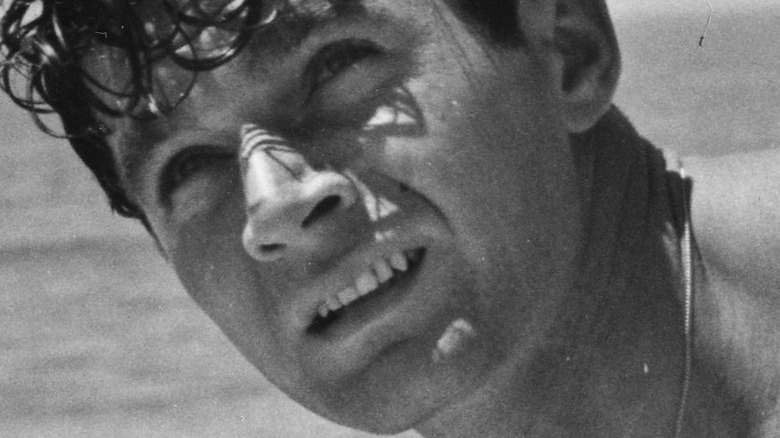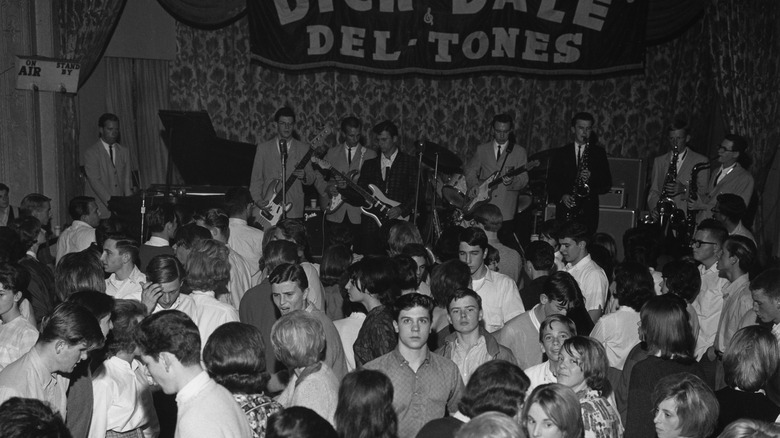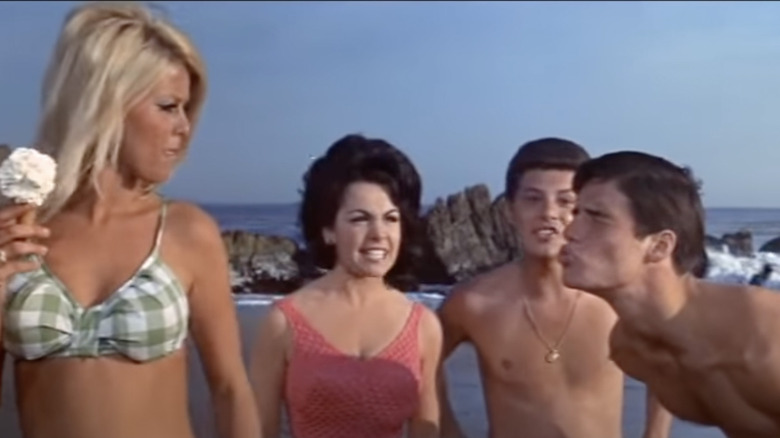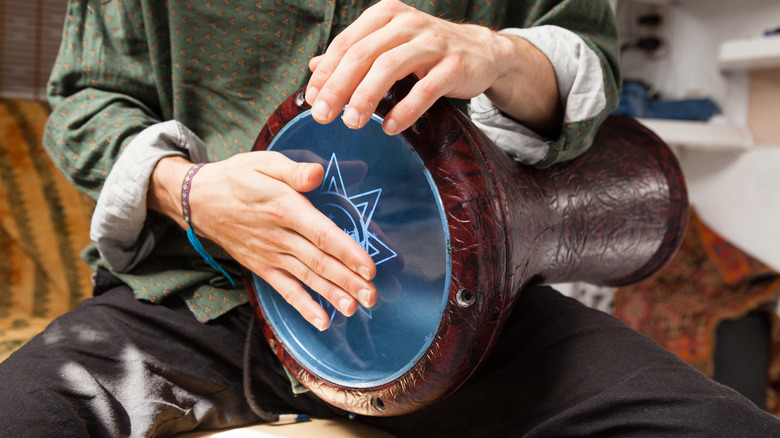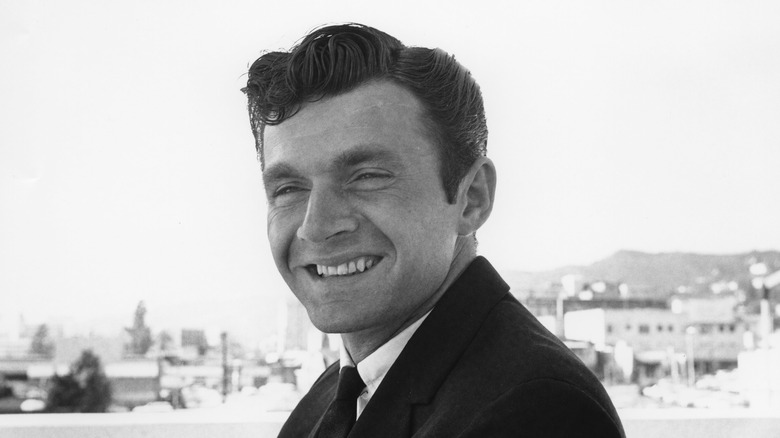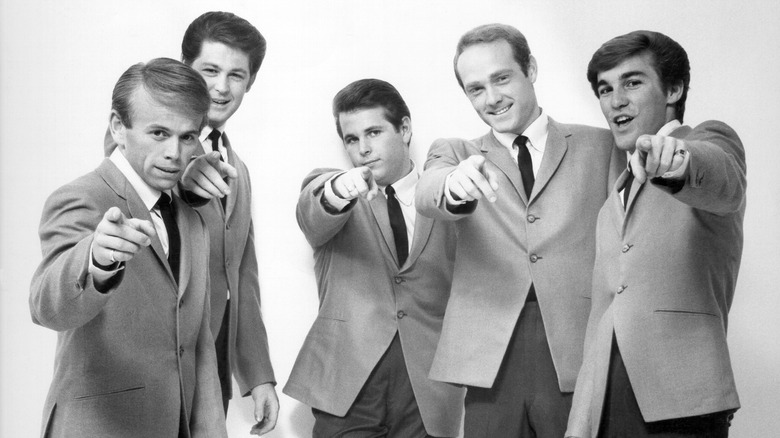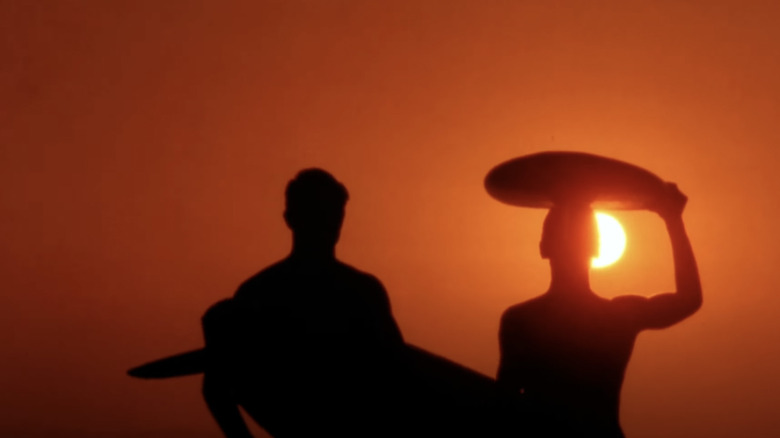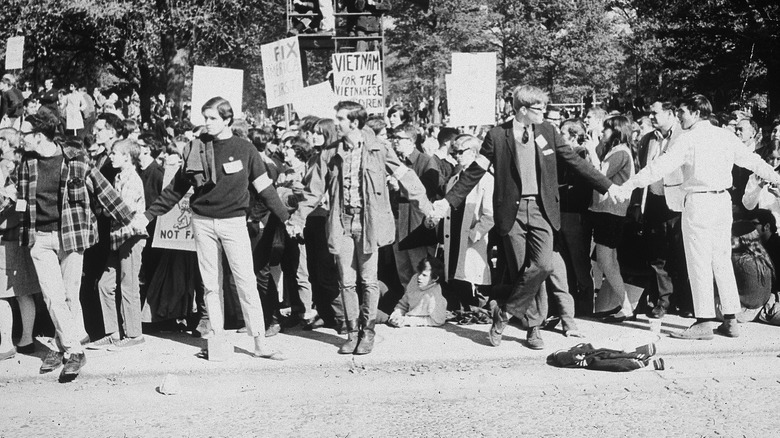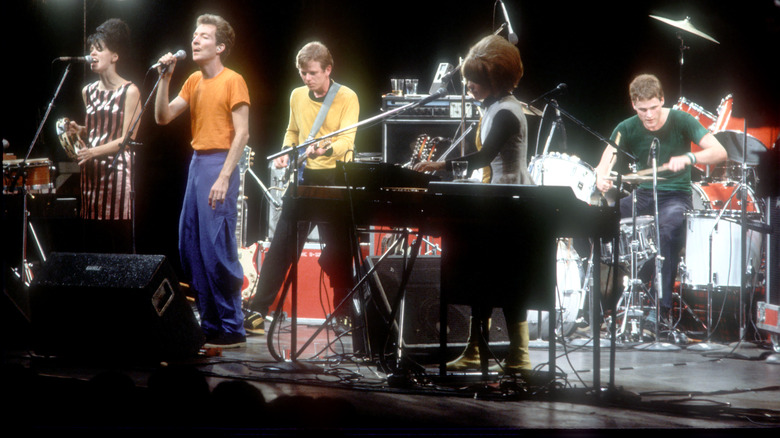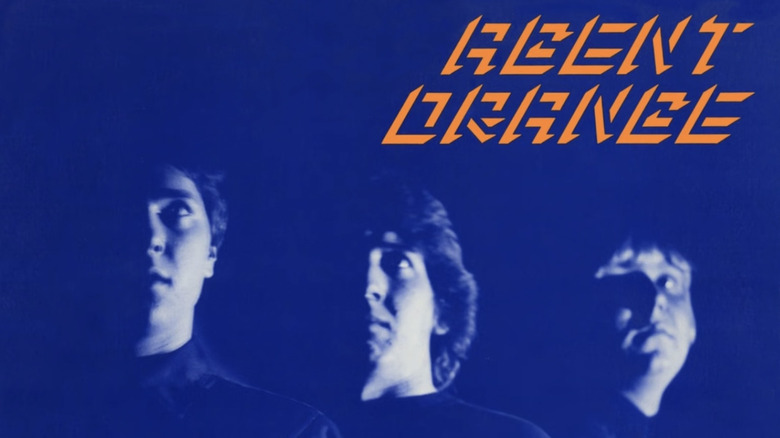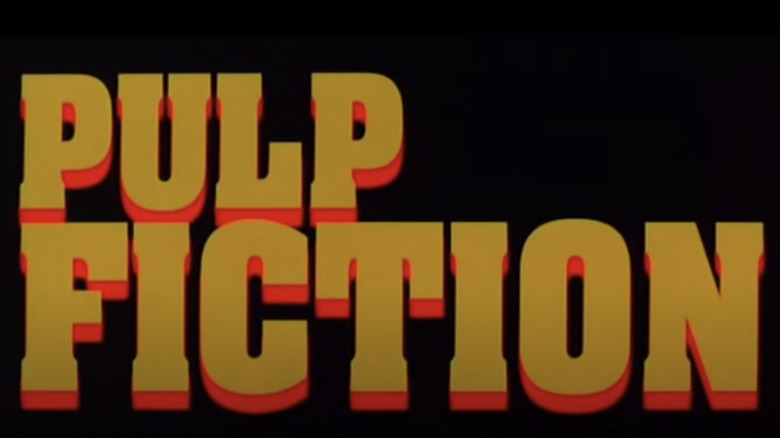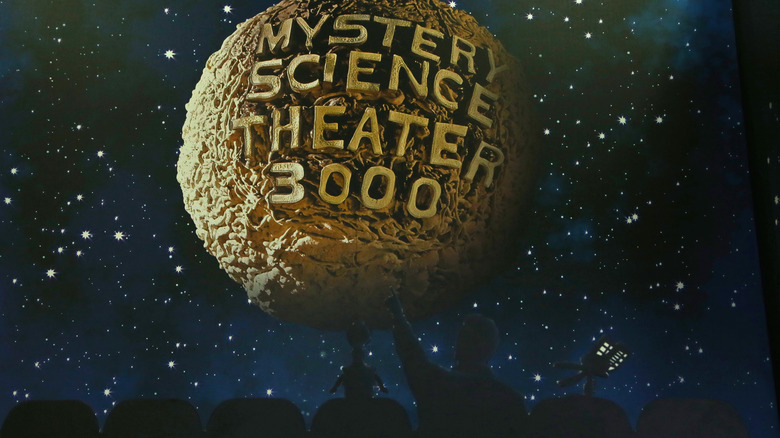The Untold Truth Of Surf Rock
What do you think of when you think of surf rock? Perhaps it's the barbershop quartet-quality harmonies of classic Beach Boys or Annette Funicello and Frankie Avalon having just the grandest time on their beach blanket in the sun and sand with gentle waves as the backdrop. Well, sure, that's one shiny side of the surf rock coin, but turn that over, and you'll see a rougher, less polished side, where a kid from Boston blew out a bunch of amps trying to get just the right sound and started a whole new genre.
Per Britannica, the surf sound can be traced to the early 1960s in Southern California. It started with the reverb-drenched mostly instrumental music (with the occasional whoop and/or yelp) of Dick Dale & His Del-Tones with "Let's Go Trippin'" and "Misirlou" and went on to the songs about girls, cars, and yes, surfing, penned and sung sweetly by the likes of Jan and Dean (like "Surf City") and the Beach Boys. But as with many genres, there was a rift between what people deemed "real surf rock," and there are as many opinions on that as there are variations on the sound. Yet, there are common elements that make surf rock, period; Surfer Today boils it down to "mood and a sonic landscape."
Regardless of what you think you know about surf rock, there's much more to it. Let's dig in.
Surf Rock Started With a Dress Code and a Faulty Soundboard
In the summer of 1961, teenage guitar shredder Dick Dale played his first live show with the Del-Tones in Southern California. As explained in Matt Warshaw's book, "The History of Surfing," Dale's supportive father persuaded some city officials and new owners of the Rendezvous Ballroom to let the band perform a "musical review" with an enforced dress code — definitely not one of those dangerous rock 'n' roll shows (via Surfer). Dale's surfer friends showed up, and the soon-to-be King of the Surf Guitar gave them complimentary cheap neckties. The evening started with music apropos to the Rendezvous' more conservative big-band past, then a few country songs, R&B, and eventually rock, which brought the crowd to their feet. Dale's surfy sound continued to develop as they played more gigs at the Rendezvous and beyond.
While Dale's musical style was certainly key in surf rock, so was the fuzz pedal and its overdriven sound — but its invention was kind of a mistake. Premier Guitar tells us that in 1960, during the recording of "Don't Worry" by Marty Robbins, there was something faulty in the channel that the bass was going through; when bassist Grady Martin played his solo, it was distorted, and yes, fuzzy. Everyone loved it, and the search for what would soon become the fuzz pedal launched. Two years later, The Ventures' "2,000 Pound Bee" buzzed onto the scene.
Surf Culture Was Definitely Not What You Saw In the Movies
Surf music as we know it sprang from the youth culture of Southern California beach towns. Golden State explained that the scene that flocked to excessively loud shows was made of teenagers addicted to surfing and music turned up so loud that they could lose themselves in it. In addition to Dick Dale & His Del-Tones, bands like the Bel-Airs and Eddie & the Showmen blew out their amps with sheer power and volume. It seemed there was often a race to get loud enough before the police had to shut everything down because of noise complaints. The music was so infused with the energy of wild Pacific Ocean waves that it rarely had a need for vocals.
Though the music was mostly regional at the time, Hollywood saw its ticket into the hearts and wallets of American teens, and soon movies such as "Beach Party," "How to Stuff a Wild Bikini," and "Beach Blanket Bingo" (pictured above) were born. An article on The Conversation reports a major disparity between genuine surf culture and the wholesome, empty-headed perpetual parties presented by stars like Frankie Avalon and Annette Funicello. The Beach Boys' string of hits like "Surfer Girl," "Fun, Fun, Fun," and "Surfin' USA" furthered this freshly-scrubbed image to an audience who had likely never even stepped foot on a surfboard.
Surf Rock Had Multicultural Roots and Influences
Surfing itself originated in Polynesia and quickly caught on in nearby Hawaii before making its way to Southern California in the early 20th century, Encyclopedia.com tells us. After a pause during World War II, surfing continued on its popular trajectory, and with it came a certain lifestyle that wasn't exactly consistent with American postwar society's rigidity. After all, dedicated surfers needed flexible work schedules that accommodated their need to surf when the waves were good. The prioritization of chasing the waves over chasing a traditional career was more in line with the Hawaiian way of living in close cooperation with nature and community.
Dick Dale's paternal grandparents had immigrated to the United States from Beirut, Lebanon, and he often talked of Arabic music's influence on his own. The New Yorker cites a 1998 interview Dale did with journalist George Baramki Azar, in which he said, "My music comes from the rhythm of Arab songs. The darbukkah, along with the wailing style of Arab singing, especially the way they use the throat, creates a very powerful force." And "Misirlou," Dale's most well-known song, is originally an eastern Mediterranean folk song, first recorded in 1927 with Greek lyrics.
The King of Surf Guitar was Born in Boston
Dick Dale was such a key player in the creation of surf rock that it seems like he must have been born in the warm waves of the Pacific Ocean, but in fact, he was born on the opposite coast in Boston, Massachusetts. Per The New Yorker, Dale was originally born Richard Monsour in 1937 and lived in Boston until he was a senior in high school. His father was a machinist and ended up taking a job at Howard Hughes's aerospace company in El Segundo, California. Dale had already been working hard at guitar, and once in California, he picked up surfing, and the rest is history.
Dale credited jazz drummer Gene Krupa with being one of his biggest influences; Krupa's crisp, rhythmic attack on the drums can be heard in Dale's own explosive, staccato style. According to Pitchfork, Dale's playing was so unique that music technology had to evolve quickly to accommodate him. Dale's amps couldn't keep up with his volume and power, and he burned through them quickly. Fortunately, Leo Fender was also from Southern California and worked with Dale to develop the "Showman" — named after the guitarist's performance skills — which was one of the very first stacked guitar amps. Not bad for a kid from Boston!
Surfers Didn't Think Much of The Beach Boys
Every art form grows and changes; some people like the original stuff best and dislike what it becomes, and surf music was no exception. HuffPost explained that two types of surf music developed: instro and vocal. The "instro" — or instrumental — school was thought to be more like the soundtrack of surfing; words were superfluous since the genre's vast, drenched-in-seawater sound captured the visceral feeling of the sport. But the vocal surf music popularized by The Beach Boys and Jan and Dean reached a national audience via those early 1960s beach party movies, and the general public loved the four-part harmonies and lyrics about the aspirational lives of suntanned babes and their beaus living in a summer that would never end.
The Beach Boys enjoyed tremendous success, but when they played in Southern California, they'd apparently get vegetables hurled at them. John Blair, author of "The Illustrated Discography of Surf Music, 1961-1965," told HuffPost, "[The Southern California surfers] thought [The Beach Boys] were purveyors of something fake. They thought they were putting something wrong on the face of instrumental music."
The Biggest Documentary About Surfing Cost $50,000 To Make
In 1966, the documentary "The Endless Summer" came out. In it, we follow two surfers — Mike Hynson and Robert August — as they traveled the world chasing the summer season in search of the perfect wave. In a 2017 interview with The Guardian, director Bruce Brown said, "The first Hollywood movies about surfing like Gidget and Beach Blanket Bingo gave the sport a bad rep. They made us out to be a bunch of idiots having food fights. We wanted to show how it really was: a legitimate sport." Brown chose Hynson and August in large part because they could pay for their own plane tickets and take the necessary three months off. The movie ended up costing $50,000 to make, which Brown paid out of his own pocket.
When they finished filming and got back to the States, Brown edited his footage and began showing it in small venues, as he had done before with other films. According to LA Weekly, word spread, and screenings quickly sold out, but despite its popularity, Brown couldn't find a distributor — he traveled across the country, renting his own spaces, and screenings consistently sold out. When Brown and his crew rented the Kips Bay Theater in New York City to rave reviews, a distributor finally paid attention. "The Endless Summer" was first distributed nationally and then internationally and ended up grossing $33 million worldwide.
Surf Music Drowned in the Cultural Revolution
Unfortunately, the first wave of surf didn't survive the decade that birthed it; after just a few years, it began to go under for a number of reasons. HuffPost said that some point the finger toward The Beatles and the subsequent British Invasion for so thoroughly influencing the public's taste in popular music away from the simpler, domestic pleasures of surf music. Others blame none other than the Beach Boys for throwing instrumental surf into the undertow; the band's career took off in part because of the widespread success of the beach party movies, where their vocal harmonies were featured. Instrumental purists blamed the band for becoming the face of surf music and crushing what they saw as the real surf music scene.
But according to LiveAbout, there were also larger cultural shifts that came about in the 1960s — such as the Vietnam War, the assassination of JFK, and the Manson family murders — that likely signalled the end of the short life of surf rock at the time. The nation's youth's focus changed because it had to — the times of hanging out at the beach and surfing were over for a lot of people, and subsequently, a once-burgeoning surf rock scene dried up, at least for the time being.
Punk Rock Resurrected Surf
Though surf rock's splash in the mainstream was brief, its ripples were felt in the burgeoning subculture of punk rock, and it enjoyed a second wave in the 1970s. John Blair, founder of rowdy surf revival band Jon and the Nightriders — as well as author of "The Illustrated Discography of Surf Music, 1961-1965" — told HuffPost that the spirit of instrumental surf rock paired perfectly with punk. "We were playing on the same stage with punk bands, and we were playing loud, and we were playing fast," he said. "The kids were picking up on it because it was exciting and not so dissimilar from the new wave bands."
As the Dana Point Times reports, East Coast punk rock poster boys The Ramones covered The Trashmen's blistering earworm "Surfin' Bird" and wrote an homage of sorts to surf rock of the '60s, "Rockaway Beach." With lyrics such as "Bus ride is too slow / They blast out the disco on the radio / Rock rock Rockaway Beach," the boys give a jet-black-hair-covered side-eye to the mainstream as they ride public transportation to a more energetic, fun place, and set a retro rock mood with the simple, catchy melody. Surf rock also melded seamlessly with other punk and new wave faves like The Cramps and the B-52s and took that scene to new, dizzying heights (per The Conversation).
Surf Music Was a Major Part of 1980s Subculture
Each new decade develops its own unique music and style, but sometimes, the trends and culture of a previous decade influence new ones. For example, as Classic Pop reports, the 1980s were kind of obsessed with the music and fashion of earlier in the 20th century, particularly the late '50s and pre-Summer of Love '60s. Tina Turner, who had hit it big in the '60s singing her heart out alongside her abusive husband, had a mind-blowingly massive comeback with "Private Dancer"; Dusty Springfield graced the Pet Shop Boys' single "What Have I Done to Deserve This?" with her cool, dulcet tones; and surf rock, which had been quietly mutating with punk and new wave for some time, had no problem surviving another decade.
On the 1981 record "Living in Darkness," California band Agent Orange is largely credited with introducing instrumental surf rock to a new generation of punks vis-à-vis their high-octane covers of surf rock classics "Misirlou," "Pipeline," and "Mr. Moto," according to the YouTube genre retrospective "Surf's Resurgence" documentary. Agent Orange covered the songs earnestly and without any silliness or satire, reportedly saying, "Instrumental surf can be punk. That's that." This resurgence would go on to inspire countless punk, garage, and surf-splinter bands, including the Mono-Men, The Mummies, the 5.6.7.8's, and The Mermen. This wasn't the sound of Top 40 in the 1980s — but it would perpetually influence college, alternative, and indie music going forward.
The Edgier Side of '90s Pop Culture Embraced Surf
When 1990 dawned, the brilliant Canadian alternative comedy group, The Kids in the Hall, were entering their 2nd television season (per Rotten Tomatoes) and gaining popularity in both Canada and the United States with their irreverent, absurd humor. Also gaining popularity was their catchy, surfy theme song, "Having an Average Weekend," by fellow Canadians Shadowy Men on a Shadowy Planet. The band's drummer, Don Pyle, told Forbes that The Kids had been using it as their theme in club gigs since the '80s and decided to keep it when they got the TV show. The song caught on especially big on college radio in the U.S., and while the mostly-instrumental band didn't identify strictly as surf, the influence permeated their most famous song, and alt-kids loved it.
Then, in 1994, Dick Dale came roaring back into the public consciousness louder than ever; director Quentin Tarantino's edgy, violent second film, "Pulp Fiction," cuts its opening scene just as a young couple begins an armed robbery in a coffee shop, and "Misirlou" blares over the introductory credits on a dark background. It is perhaps one of the coolest openings in modern film. In an interview posted on YouTube, Tarantino said, "Having 'Misirlou' as your opening credit, it's just so intense ... It just throws down a gauntlet that the movie now has to live up to." The movie and its soundtrack helped usher in a broader interest in surf rock that stuck around.
Surf Rock Intersected with Sci-Fi
Infinite varieties of surf-influenced bands in the '90s put their own unique spin on the genre. One such band was Man or Astro-man?, formed in Auburn, Alabama, in the early 90s. They sampled retro sci-fi movies on their largely instrumental and surf-laden records, wore spaceman-looking jumpsuits, dodged bolts from a janky-looking Tesla coil, and donned personas of extraterrestrials stranded on Earth (via the band's official website).
Meanwhile, a ragtag bunch of sci-fi fans in Minnesota made a hilarious little show called "Mystery Science Theater 3000" (MST3K), in which a human that has been shot into space and two robot friends pass the time by watching old sci-fi movies, skewering the cheesiness with surgical comic timing. According to Rolling Stone, it originally aired on a Minneapolis UHF station in 1988 and gained fans through unofficial sharing of VHS tapes, eventually landing it a spot on Comedy Central in the mid-90s.
Man or Astro-man? were early fans, and in 1994, recorded a cover of its theme song. The official MST3K website reported that Joel Hodgson — the actor who played the aforementioned shot-into-space guy — heard the cover and loved it so much that he joined the band onstage in 1996 to help sing it. Hodgson would go on to leave the show and then return for a cameo in the 1999 episode "Soultaker," where he claims that in his absence, he'd fallen in with Man or Astro-Man? back on Earth doing "pyrotechniques" (via YouTube). The crossover was seamless.
Surf Music Lives On
To this day, surf rock is still a bona fide and much-loved genre. Alternative Press reported in 2019 that there were many modern bands springboarding off surf rock that caught their ears, including the dreamy-yet-dark post-punk bass-heavy sound and intricate harmonies of all-women band La Luz, fun punk/surf hybrid Babewatch, and the psychedelic/surf hybrid of U.K. natives Dead Coast, among others.
Bandcamp has its own roster of surf bands, all with excellent names, keeping the original, rowdy spirit alive and well. The artist-positive site pontificates on how a genre like surf rock, born of such a specific time and place, can still resonate so loudly with all sorts of musicians and music fans some 60 years after emerging from the shining Pacific waves. One possibility is that, as much as musicians have blended surf with other genres over the decades, there is still a very definite sound that has to be there in order for it to be "surfy:" It has to have reverb, a certain amount of fuzz, and a surplus of energy that gets audiences up and dancing. This kernel of surf has the power to both harken back to that certain time and place and set us dreaming about the possibilities of the wide-open future. The fact that it's infectiously danceable certainly doesn't hurt, either.
